
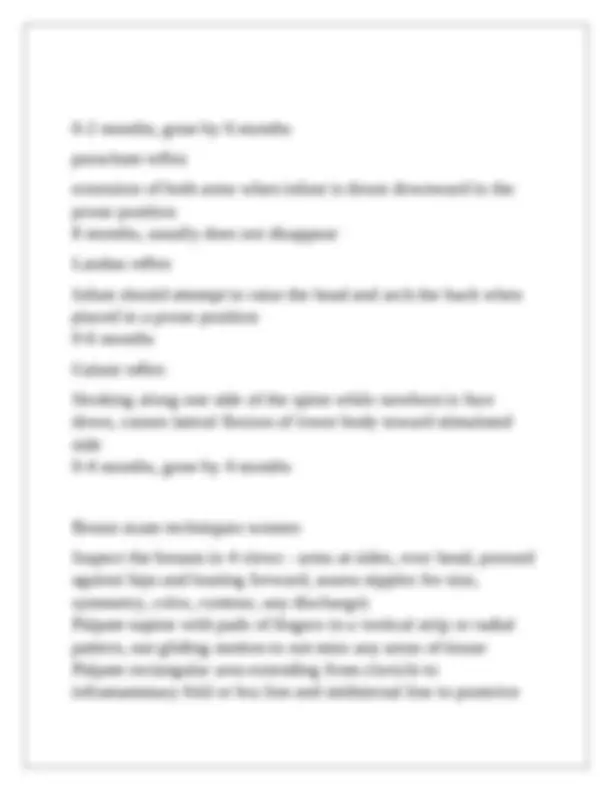
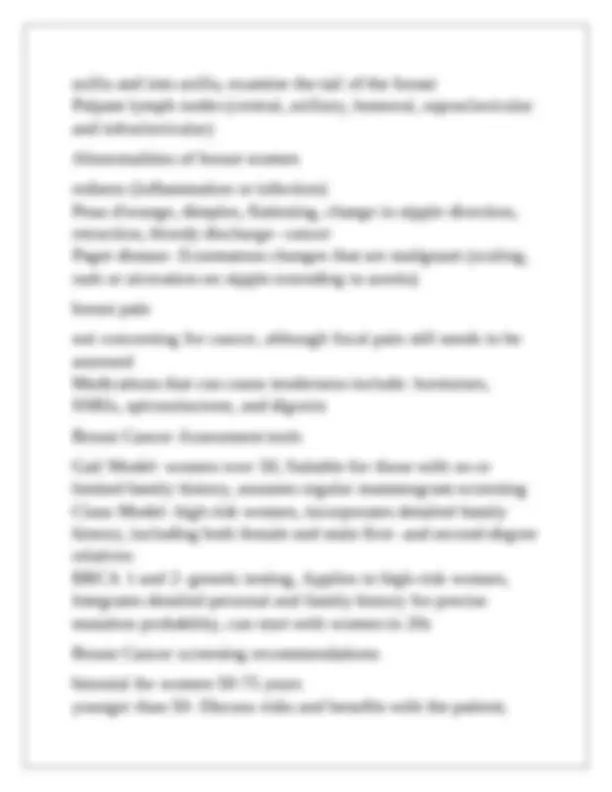
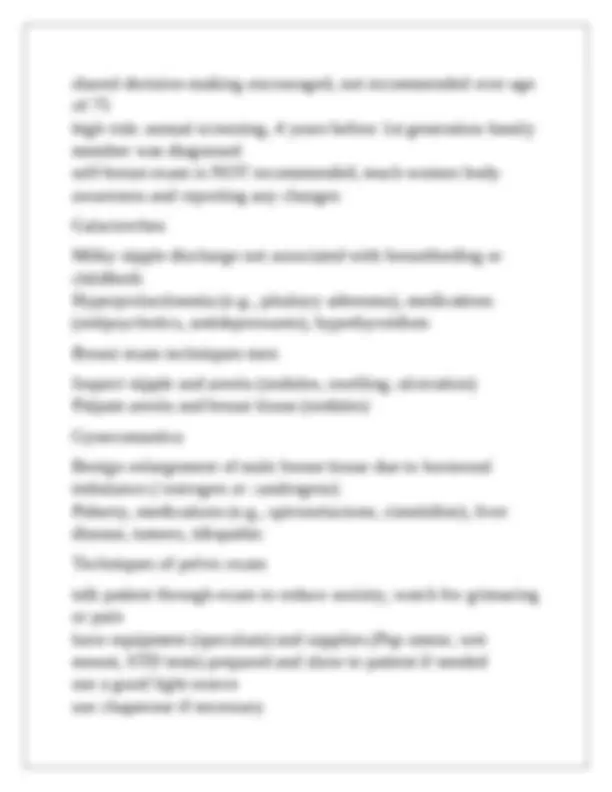
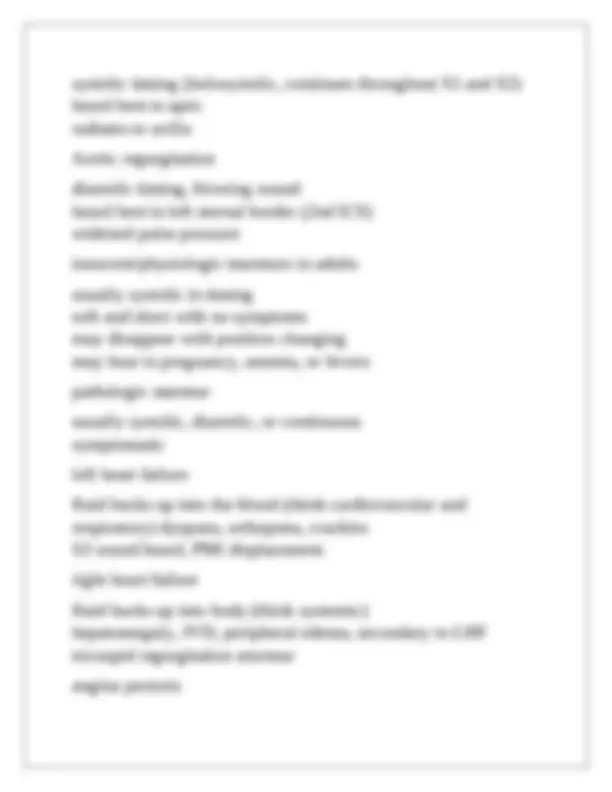
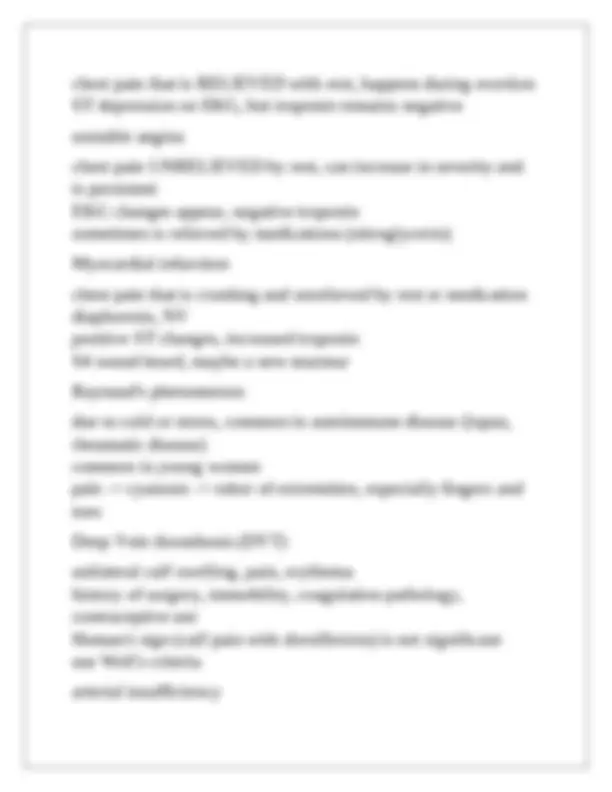
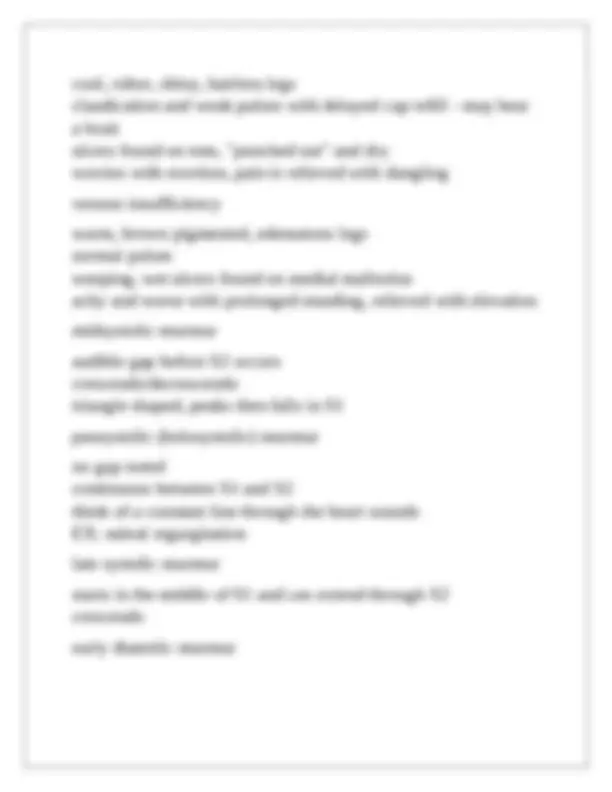
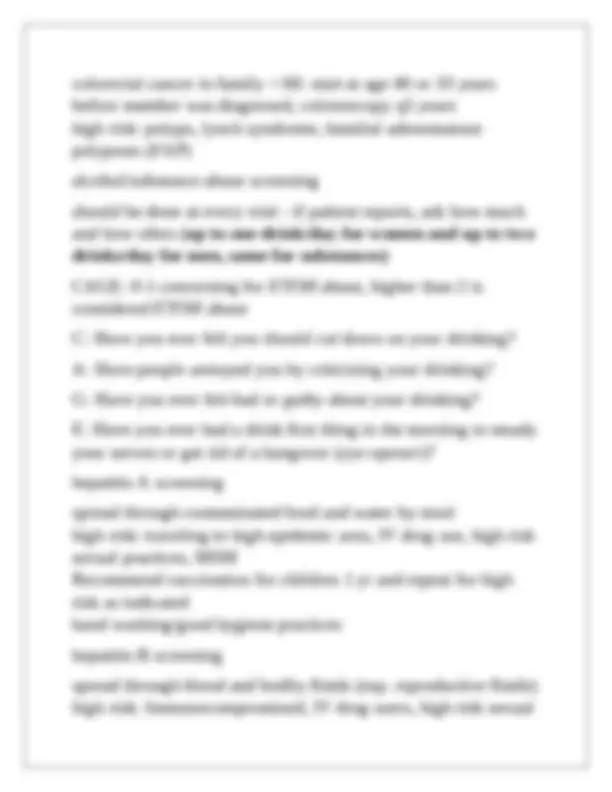
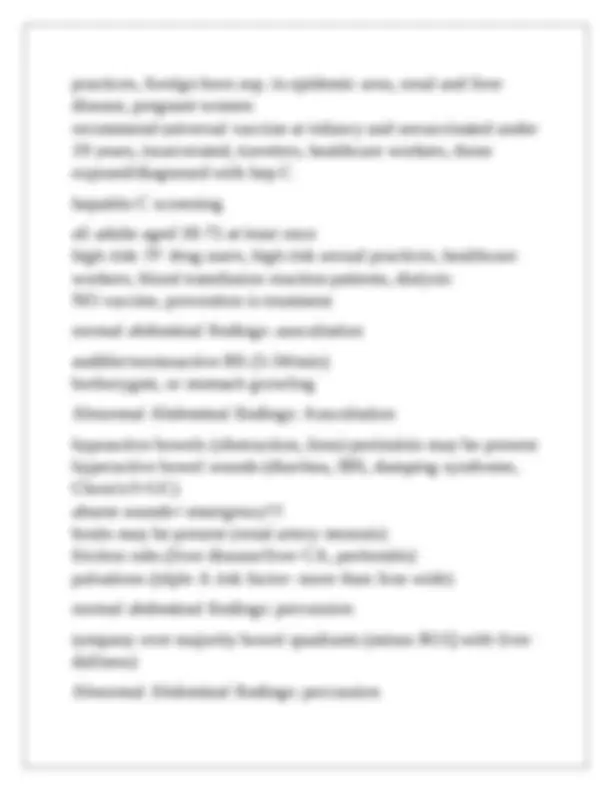
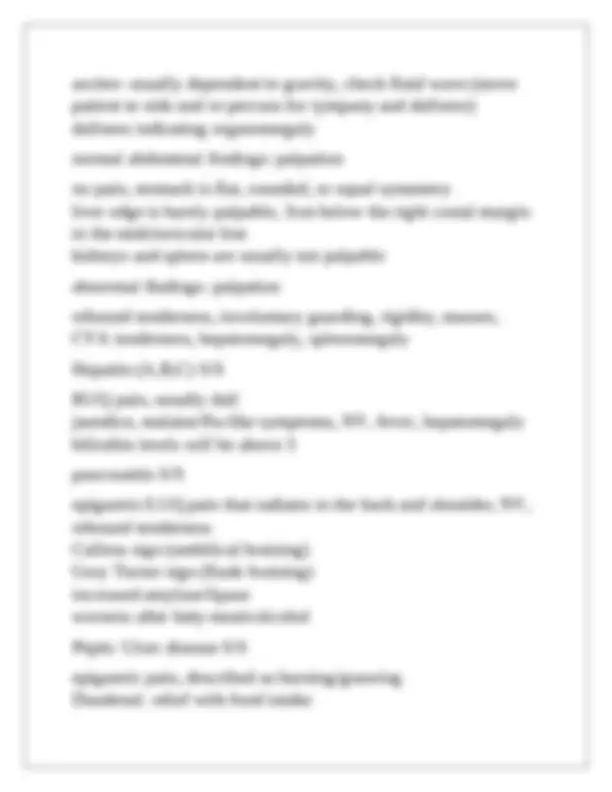
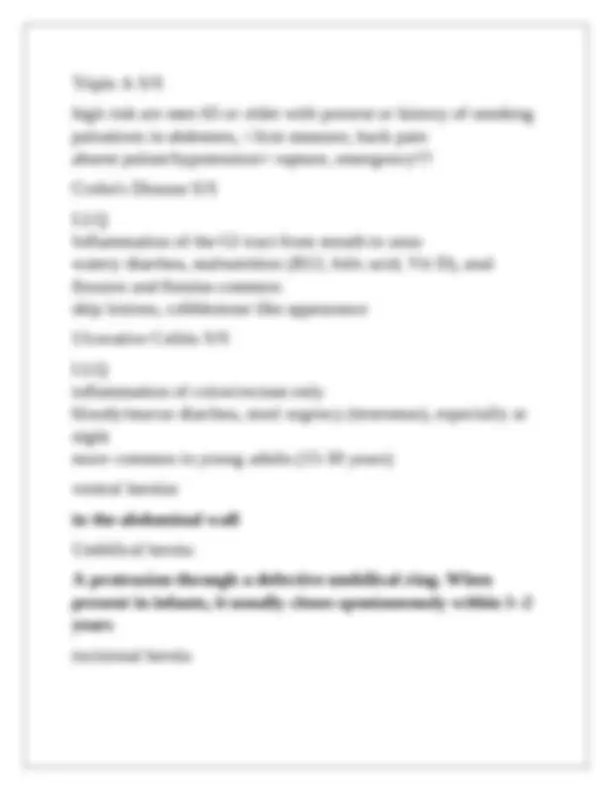
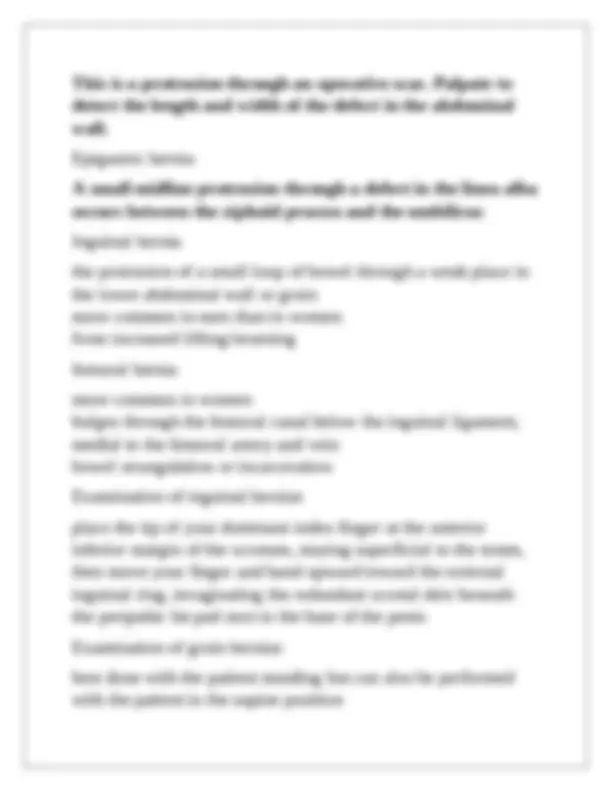
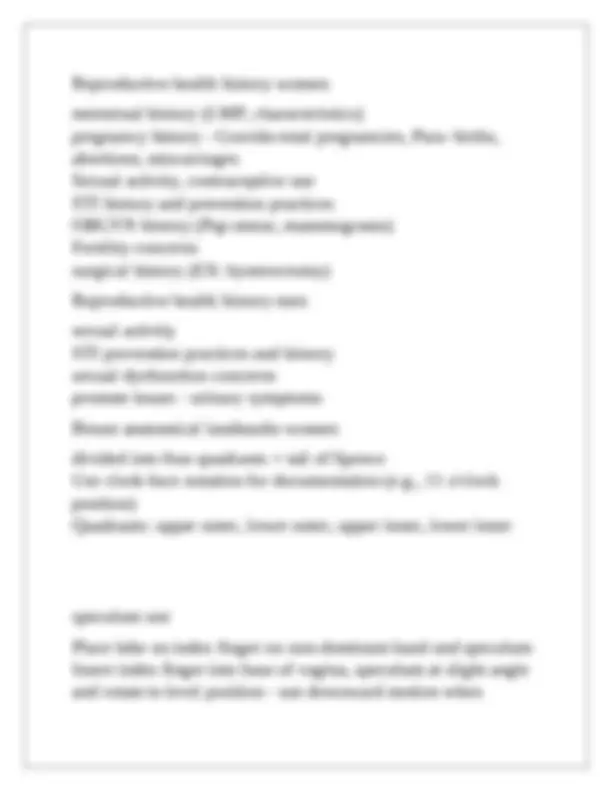
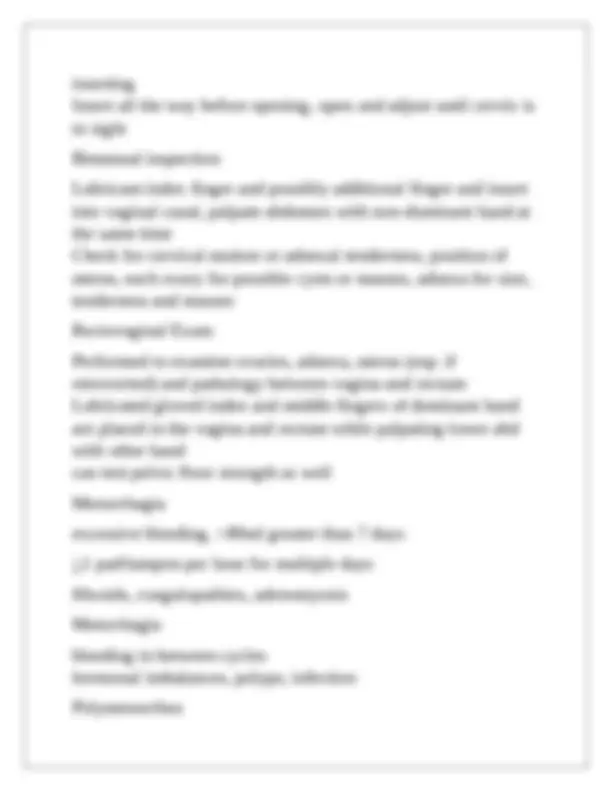
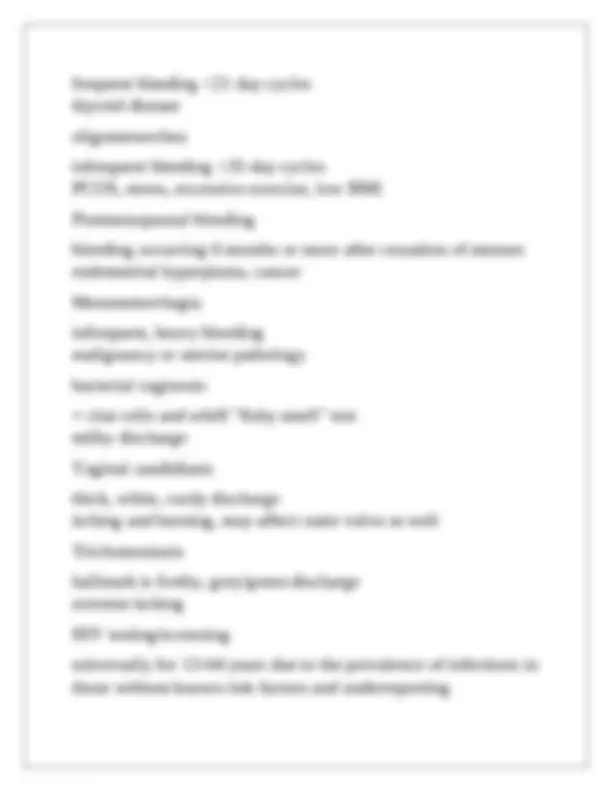
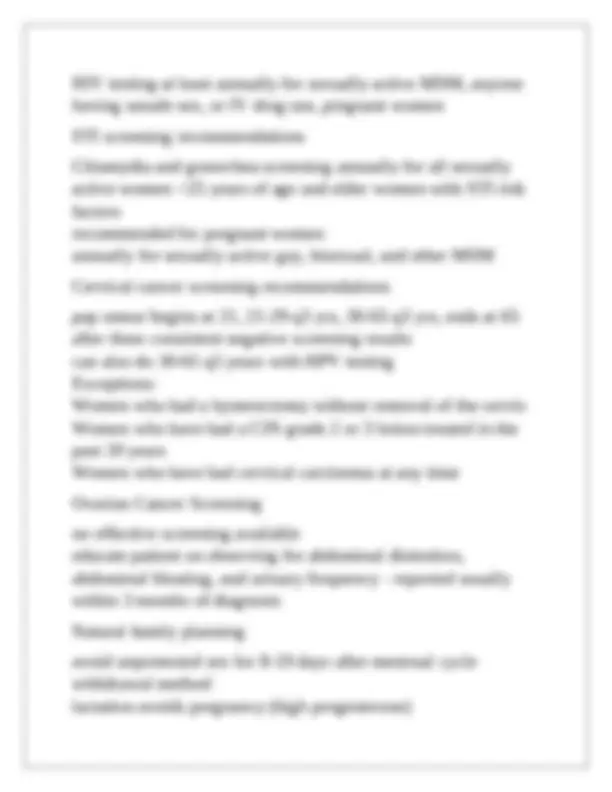
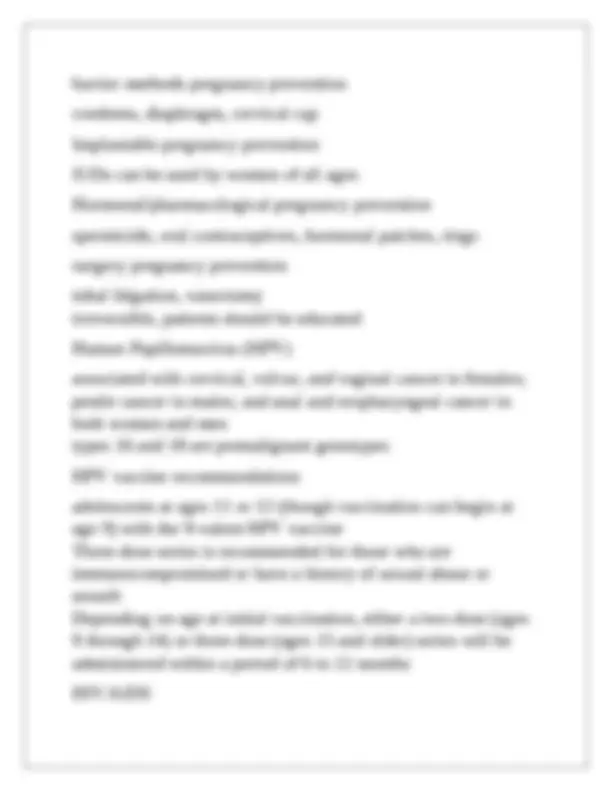
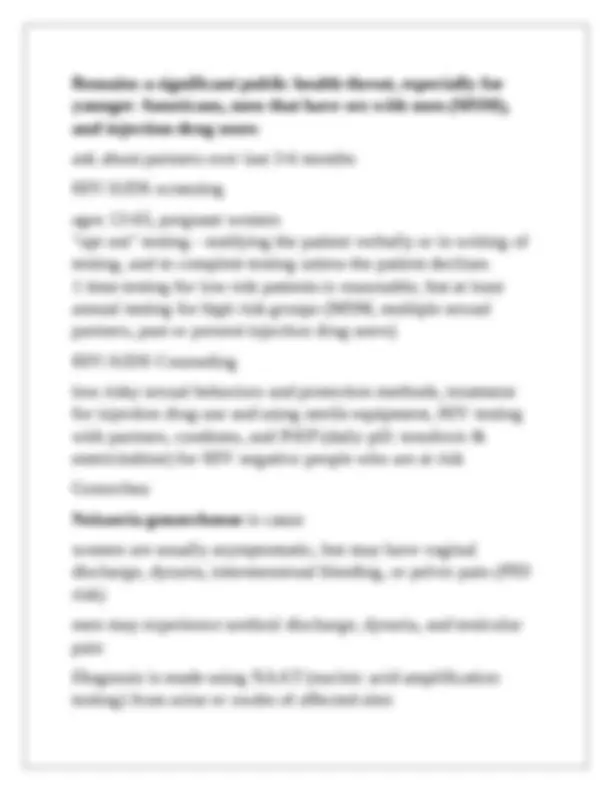
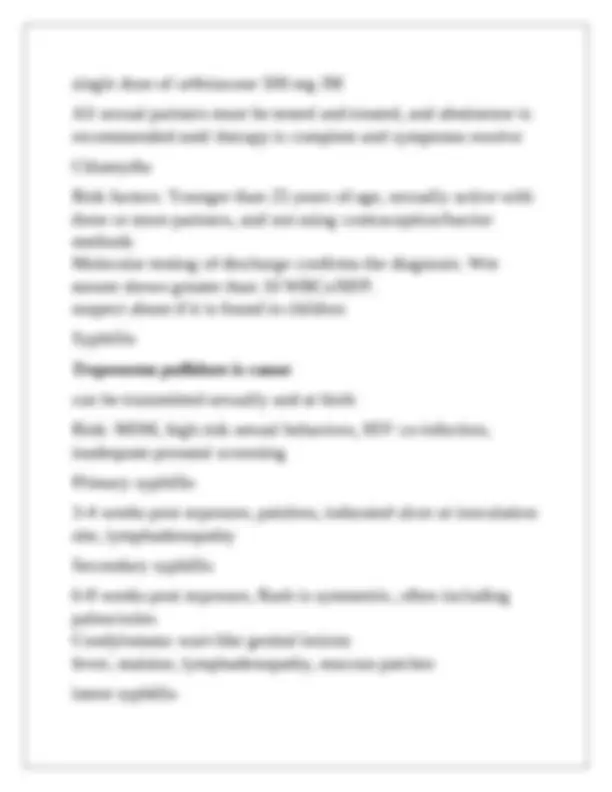
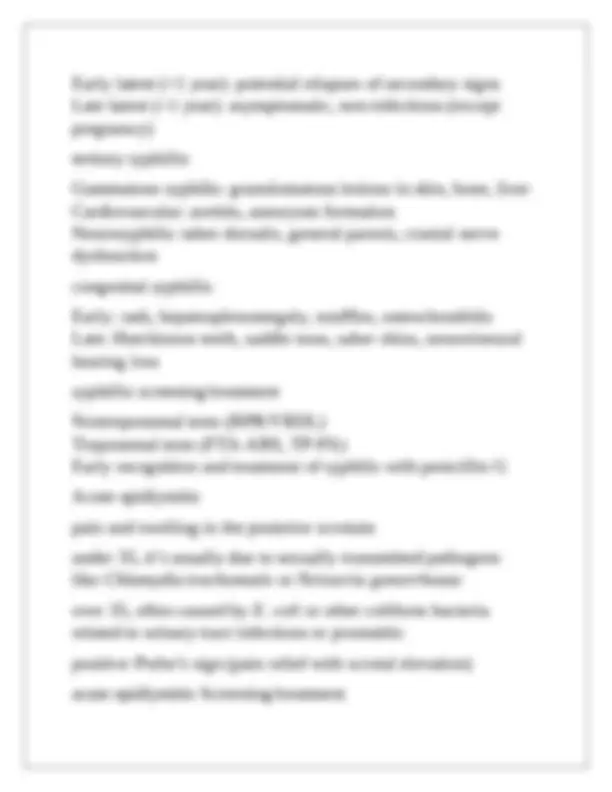
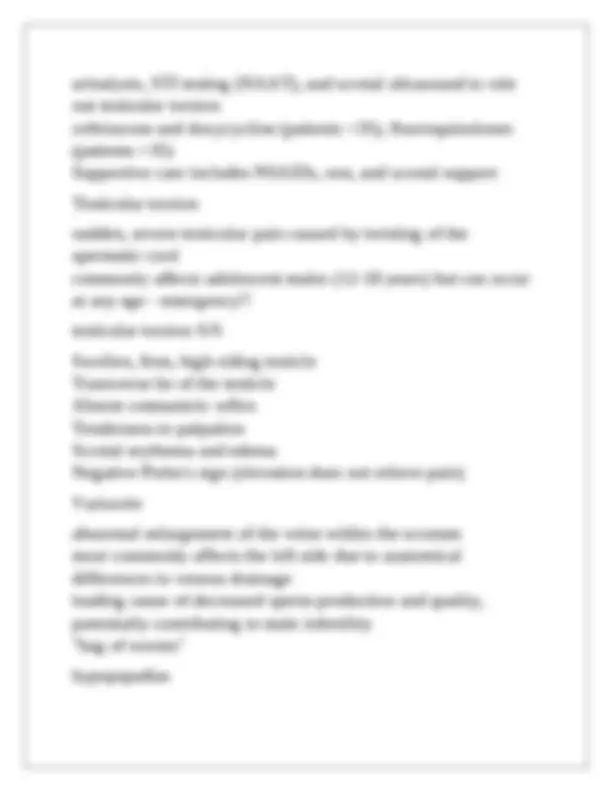

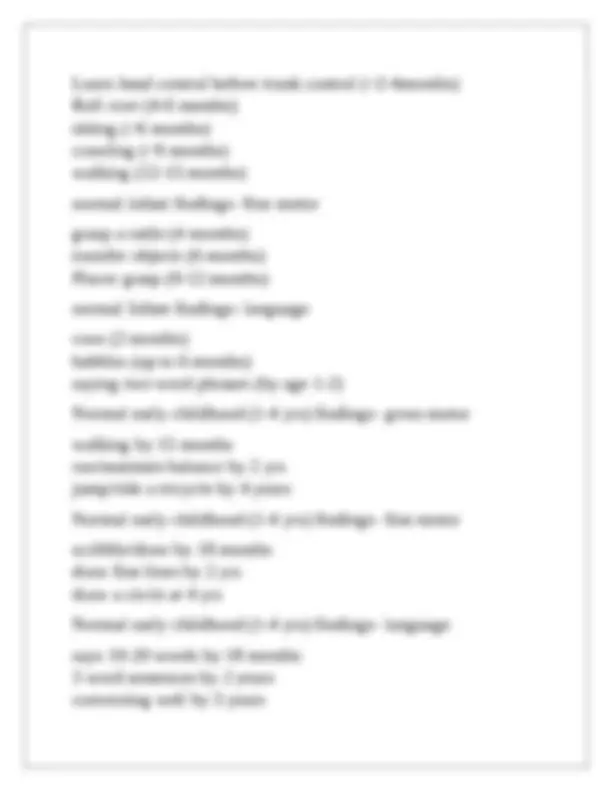
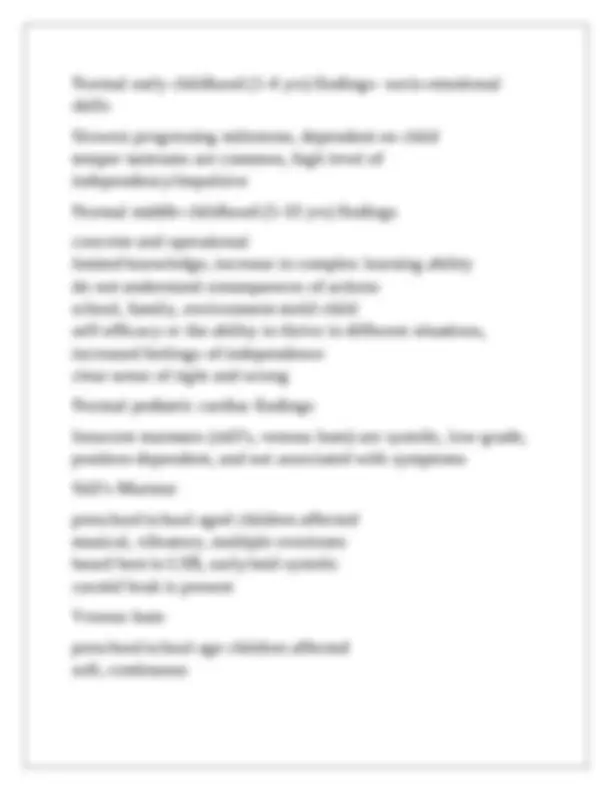
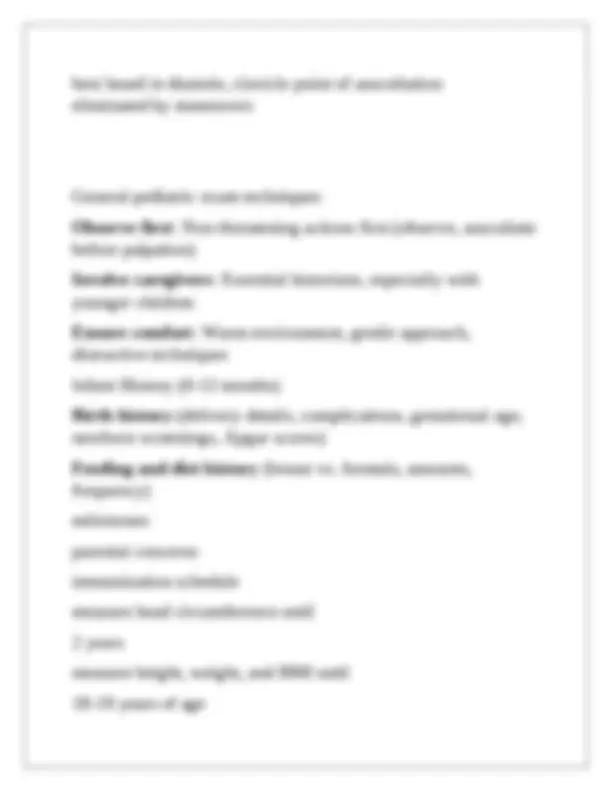
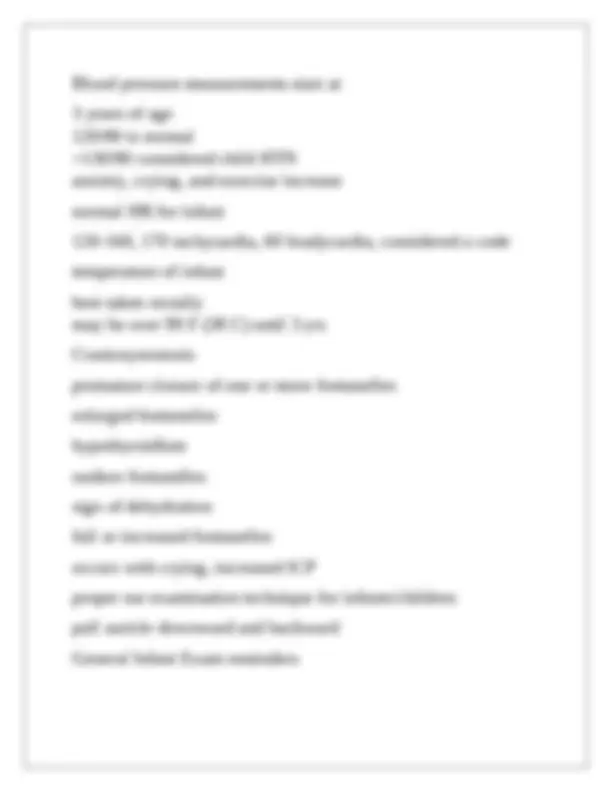
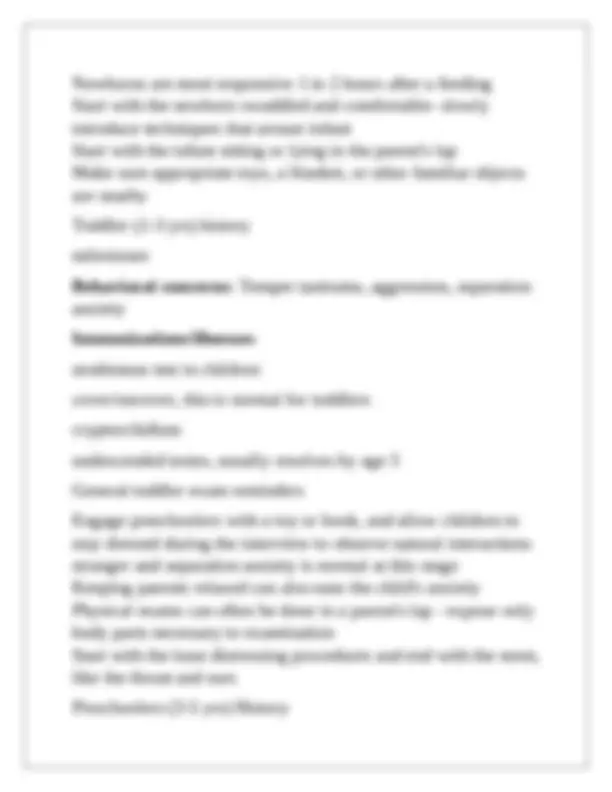
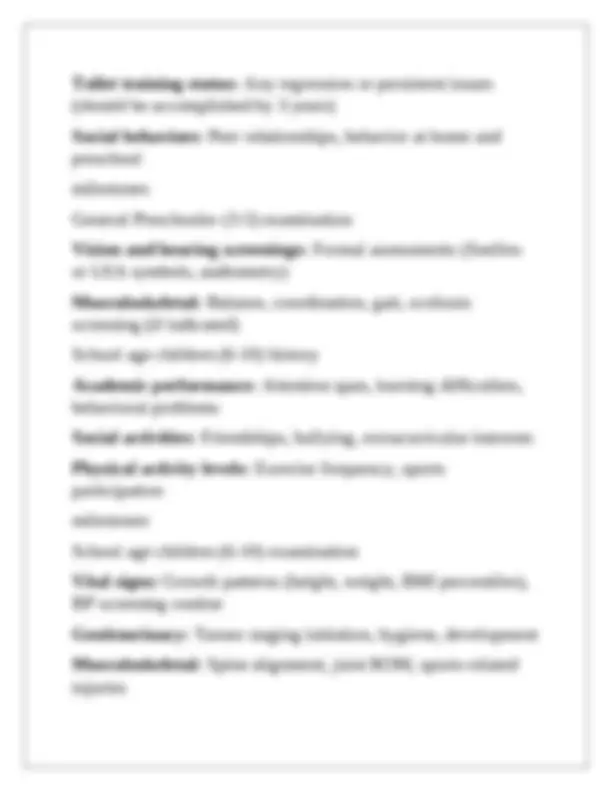
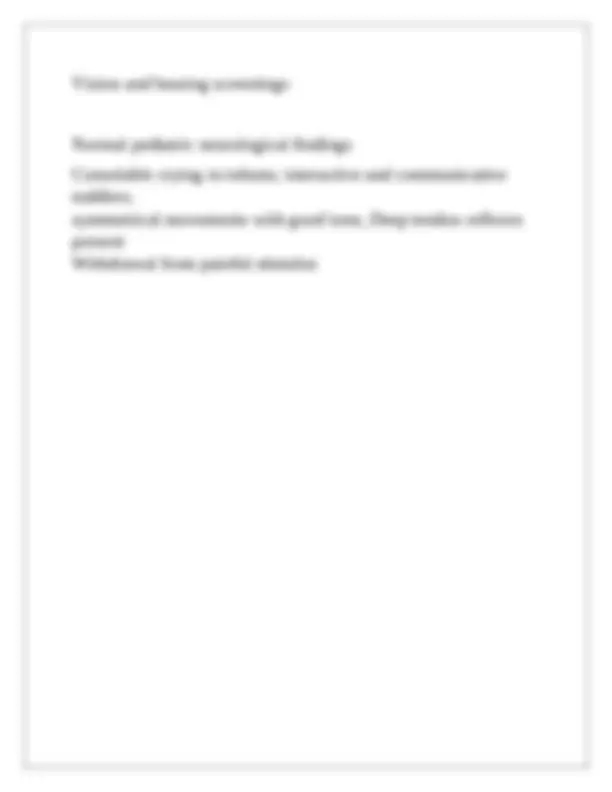


Study with the several resources on Docsity

Earn points by helping other students or get them with a premium plan


Prepare for your exams
Study with the several resources on Docsity

Earn points to download
Earn points by helping other students or get them with a premium plan
Community
Ask the community for help and clear up your study doubts
Discover the best universities in your country according to Docsity users
Free resources
Download our free guides on studying techniques, anxiety management strategies, and thesis advice from Docsity tutors
NUR 5354 Exam 2 Questions With Complete Solutions
Typology: Exams
1 / 36

This page cannot be seen from the preview
Don't miss anything!





























NUR 5354 Exam 2 Questions With Complete Solutions Abnormal pediatric cardiac findings Fatigue during feeding, esp. diaphoresis Central cyanosis (tongue, lips), especially during crying or feeding lethargy, irritability Diastolic murmur, harsh or loud murmur (>grade 3), pansystolic murmur, murmur with thrill or cyanosis or abnormal vital signs Fixed split S2 (ASD), single S2 (severe TOF), loud P (pulmonary hypertension) abnormal pediatric neurological findings Asymmetrical limb movement or posturing (e.g., hemiparesis) Weakness or flaccidity in any limb Poor visual tracking or lack of blink reflex (CN II) No response to loud sounds (CN VIII) Hoarse cry, nasal regurgitation, weak gag reflex (CN IX, X) Weak or absent suck reflex (CN V, VII, IX) Moro/startle reflex stimulus: loud noises or sudden movement response: extend arms and legs; throw head and neck back 0-4 months, gone by 4-6 months rooting reflex
an infant's response in turning toward the source of touching that occurs anywhere around his or her mouth 0-4 months, gone by 3-4 months palmar grasp reflex reflexive curling of the infant's fingers around an object that touches its palm 0-4 months, gone by 4-6 months plantar grasp reflex (babinski) reaction to stimulation of the sole of the foot that causes the toes of the feet to curl 0-8 months, gone by 8 months Asymmetric tone neck reflex turning infant's head to one side, that leg and arm will extend while the opposite flexes 0-3 months, gone by 3 months stepping reflex Reflex that causes newborn babies to make little stepping motions if they are held upright with their feet just touching a surface best visible by 4 days, dependent on infant development for disappearance positive support reflex Weight placed on balls of feet of infant Stiffening of legs and trunk into extension for 20-30 seconds
axilla and into axilla, examine the tail of the breast Palpate lymph nodes (central, axillary, humoral, supraclavicular and infraclavicular) Abnormalities of breast women redness (inflammation or infection) Peau d'orange, dimples, flattening, change in nipple direction, retraction, bloody discharge- cancer Paget disease- Eczematous changes that are malignant (scaling, rash or ulceration on nipple extending to areola) breast pain not concerning for cancer, although focal pain still needs to be assessed Medications that can cause tenderness include: hormones, SSRIs, spironolactone, and digoxin Breast Cancer Assessment tools Gail Model- women over 50, Suitable for those with no or limited family history, assumes regular mammogram screening Claus Model- high risk women, incorporates detailed family history, including both female and male first- and second-degree relatives BRCA 1 and 2- genetic testing, Applies to high-risk women, Integrates detailed personal and family history for precise mutation probability, can start with women in 20s Breast Cancer screening recommendations biennial for women 50-75 years younger than 50- Discuss risks and benefits with the patient;
shared decision-making encouraged, not recommended over age of 75 high risk: annual screening, 4 years before 1st generation family member was diagnosed self-breast exam is NOT recommended, teach women body awareness and reporting any changes Galactorrhea Milky nipple discharge not associated with breastfeeding or childbirth Hyperprolactinemia (e.g., pituitary adenoma), medications (antipsychotics, antidepressants), hypothyroidism Breast exam techniques men Inspect nipple and areola (nodules, swelling, ulceration) Palpate areola and breast tissue (nodules) Gynecomastica Benign enlargement of male breast tissue due to hormonal imbalance (↑estrogen or ↓androgens) Puberty, medications (e.g., spironolactone, cimetidine), liver disease, tumors, idiopathic Techniques of pelvic exam talk patient through exam to reduce anxiety, watch for grimacing or pain have equipment (speculum) and supplies (Pap smear, wet mount, STD tests) prepared and show to patient if needed use a good light source use chaperone if necessary
LVH, hypertension, aortic stenosis heard in apex with bell Split S2 heart sound split of A2 and P2 heard during inspiration normal variation best heard at Erb's point, 2nd Intercostal space near sternal border mitral valve prolapse (MVP) mid-systolic click, late systolic murmur often asymptomatic, may cause chest pain, anxiety and palpitations seen in young, thin females mitral stenosis opening snap during diastole, rumbling sound seen in rheumatic disease best heard in apex aortic stenosis systolic timing heard best in right 2nd intercostal space, esp. when patient sits up and leans forward often accompanies bruits in carotids S4 sound, syncope and angina harsh sounding mitral regurgitation
systolic timing (holosystolic, continues throughout S1 and S2) heard best in apex radiates to axilla Aortic regurgitation diastolic timing, blowing sound heard best in left sternal border (2nd ICS) widened pulse pressure innocent/physiologic murmurs in adults usually systolic in timing soft and short with no symptoms may disappear with position changing may hear in pregnancy, anemia, or fevers pathologic murmur usually systolic, diastolic, or continuous symptomatic left heart failure fluid backs up into the blood (think cardiovascular and respiratory) dyspnea, orthopnea, crackles S3 sound heard, PMI displacement right heart failure fluid backs up into body (think systemic) hepatomegaly, JVD, peripheral edema, secondary to LHF tricuspid regurgitation murmur angina pectoris
cool, rubor, shiny, hairless legs claudication and weak pulses with delayed cap refill - may hear a bruit ulcers found on toes, "punched out" and dry worries with exertion, pain is relieved with dangling venous insufficiency warm, brown pigmented, edematous legs normal pulses weeping, wet ulcers found on medial malleolus achy and worse with prolonged standing, relieved with elevation midsystolic murmur audible gap before S2 occurs crescendo/decrescendo triangle shaped, peaks then falls in S pansystolic (holosystolic) murmur no gap noted continuous between S1 and S think of a constant line through the heart sounds EX: mitral regurgitation late systolic murmur starts in the middle of S1 and can extend through S crescendo early diastolic murmur
starts immediately after S2 without gap and fades before start of new S EX: S3 sound, ventricular gallop middiastolic murmur starts a short time after S2 and can overlap with a late diastolic murmur decrescendo late diastolic murmur late into diastole and can begin in next S1 cycle crescendo EX: S4 sound, atrial gallop pulmonic stenosis harsh sounding heard best in 2nd ICS, LSB Pulmonic regurgitation blowing sound heard best in 2nd ICS, LSB Tricuspid regurgitation located at lower L sternal border (4th ICS) radiates to RSB blowing murmur that sounds the same throughout systole Levine's grading system I: barely audible II: audible, faint III: audible with no thrill
colorectal cancer in family < 60: start at age 40 or 10 years before member was diagnosed, colonoscopy q5 years high risk: polyps, lynch syndrome, familial adenomatous polyposis (FAP) alcohol/substance abuse screening should be done at every visit - if patient reports, ask how much and how often ( up to one drink/day for women and up to two drinks/day for men, same for substances) CAGE: 0-1 concerning for ETOH abuse, higher than 2 is considered ETOH abuse C: Have you ever felt you should cut down on your drinking? A: Have people annoyed you by criticizing your drinking? G: Have you ever felt bad or guilty about your drinking? E: Have you ever had a drink first thing in the morning to steady your nerves or get rid of a hangover ( eye-opener )? hepatitis A screening spread through contaminated food and water by stool high risk: traveling to high epidemic area, IV drug use, high risk sexual practices, MSM Recommend vaccination for children 1 yr and repeat for high risk as indicated hand washing/good hygiene practices hepatitis B screening spread through blood and bodily fluids (esp. reproductive fluids) high risk: Immunocompromised, IV drug users, high risk sexual
practices, foreign born esp. in epidemic area, renal and liver disease, pregnant women recommend universal vaccine at infancy and unvaccinated under 19 years, incarcerated, travelers, healthcare workers, those exposed/diagnosed with hep C hepatitis C screening all adults aged 18-75 at least once high risk: IV drug users, high risk sexual practices, healthcare workers, blood transfusion reaction patients, dialysis NO vaccine, prevention is treatment normal abdominal findings: auscultation audible/normoactive BS (5-34/min) borborygmi, or stomach growling Abnormal Abdominal findings: Auscultation hypoactive bowels (obstruction, ileus) peristalsis may be present hyperactive bowel sounds (diarrhea, IBS, dumping syndrome, Chron's/I+UC) absent sounds= emergency!!! bruits may be present (renal artery stenosis) friciton rubs (liver disease/liver CA, peritonitis) pulsations (triple A risk factor- more than 3cm wide) normal abdominal findings: percussion tympany over majority bowel quadrants (minus RUQ with liver dullness) Abnormal Abdominal findings: percussion
Gastric: worse with food intake H. pylori or NSAIDS are common causes heartburn, early satiety, reflux, loss of appetite, weight loss Cholecystitis S/S RUQ pain that is constant Murphy's sign (+pain with deep inhalation) guarding, rebound tenderness will have fever, leukocytosis imaging shows stones or organ wall thickening TPN, tumors, bile duct strictures, infections (e.coli, klebsiella) Cholelithiasis S/S RUQ pain that is intermittent with + Murphy's sign Ultrasound will show stones obesity, women, Native American ethnicity usually found accidentally on imaging Diverticulitis S/S LLQ pain fever and leukocytosis, rebound tenderness CT scan will be diagnostic Diverticulosis S/S patients are usually asymptomatic, some LLQ pain usually found incidentally on imaging colonoscopy painless rectal bleeding Pyelonephritis S/S
e.coli is common culprit, ascending UTI from bladder high risk: VUR, urinary obstruction, catheters, diabetes, pregnancy positive CVA tenderness, fever, chills, flank pain, urinary frequency, urgency, etc. urinalysis and culture should be obtained, cloudy and foul smelling Cirrhosis S/S RUQ pain, painless jaundice, ascites, history of ETOH or carcinoma, varices, hepatic encephalopathy, palmar erythema, spider anginomas low platelet and albumin counts diagnosis is with imaging and biopsy may be done Appendicitis S/S RLQ pain, usually sudden and severe (suddenly relieves= perforation, emergency!!!) NV, anorexia, fever McBurney's point, Rosving's sign (palpation of LLQ elicits RLQ pain) and Psoas sign (Side lying, Passively extend the patient's right thigh) US or CT confirms, will need surgery Peritonitis S/S Rigid, board-like abdomen, rebound tenderness, involuntary guarding fever, leukocytosis surgical emergency
This is a protrusion through an operative scar. Palpate to detect the length and width of the defect in the abdominal wall. Epigastric hernia A small midline protrusion through a defect in the linea alba occurs between the xiphoid process and the umbilicus Inguinal hernia the protrusion of a small loop of bowel through a weak place in the lower abdominal wall or groin more common in men than in women from increased lifting/straining femoral hernia more common in women bulges through the femoral canal below the inguinal ligament, medial to the femoral artery and vein bowel strangulation or incarceration Examination of inguinal hernias place the tip of your dominant index finger at the anterior inferior margin of the scrotum, staying superficial to the testes, then move your finger and hand upward toward the external inguinal ring, invaginating the redundant scrotal skin beneath the peripubic fat pad next to the base of the penis Examination of groin hernias best done with the patient standing but can also be performed with the patient in the supine position
Reproductive health history women menstrual history (LMP, characteristics) pregnancy history - Gravida-total pregnancies, Para- births, abortions, miscarriages Sexual activity, contraceptive use STI history and prevention practices OBGYN history (Pap smear, mammograms) Fertility concerns surgical history (EX: hysterectomy) Reproductive health history men sexual activity STI prevention practices and history sexual dysfunction concerns prostate issues - urinary symptoms Breast anatomical landmarks women divided into four quadrants + tail of Spence Use clock-face notation for documentation (e.g., 11 o'clock position) Quadrants: upper outer, lower outer, upper inner, lower inner speculum use Place lube on index finger on non-dominant hand and speculum Insert index finger into base of vagina, speculum at slight angle and rotate to level position - use downward motion when